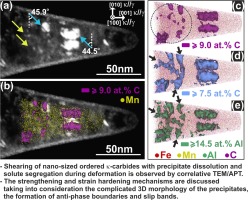当前位置:
X-MOL 学术
›
Acta Mater.
›
论文详情
Our official English website, www.x-mol.net, welcomes your
feedback! (Note: you will need to create a separate account there.)
Strengthening and strain hardening mechanisms in a precipitation-hardened high-Mn lightweight steel
Acta Materialia ( IF 8.3 ) Pub Date : 2017-11-01 , DOI: 10.1016/j.actamat.2017.08.049 M.J. Yao , E. Welsch , D. Ponge , S.M.H. Haghighat , S. Sandlöbes , P. Choi , M. Herbig , I. Bleskov , T. Hickel , M. Lipinska-Chwalek , P. Shanthraj , C. Scheu , S. Zaefferer , B. Gault , D. Raabe
Acta Materialia ( IF 8.3 ) Pub Date : 2017-11-01 , DOI: 10.1016/j.actamat.2017.08.049 M.J. Yao , E. Welsch , D. Ponge , S.M.H. Haghighat , S. Sandlöbes , P. Choi , M. Herbig , I. Bleskov , T. Hickel , M. Lipinska-Chwalek , P. Shanthraj , C. Scheu , S. Zaefferer , B. Gault , D. Raabe

|
Abstract We report on the strengthening and strain hardening mechanisms in an aged high-Mn lightweight steel (Fe-30.4Mn-8Al-1.2C, wt.%) studied by electron channeling contrast imaging (ECCI), transmission electron microscopy (TEM), atom probe tomography (APT) and correlative TEM/APT. Upon isothermal annealing at 600 °C, nano-sized κ-carbides form, as characterized by TEM and APT. The resultant alloy exhibits high strength and excellent ductility accompanied by a high constant strain hardening rate. In comparison to the as-quenched κ-free state, the precipitation of κ-carbides leads to a significant increase in yield strength (∼480 MPa) without sacrificing much tensile elongation. To study the strengthening and strain hardening behavior of the precipitation-hardened material, deformation microstructures were analyzed at different strain levels. TEM and correlative TEM/APT results show that the κ-carbides are primarily sheared by lattice dislocations, gliding on the typical face-centered-cubic (fcc) slip system {111} , leading to particle dissolution and solute segregation. Ordering strengthening is the predominant strengthening mechanism. As the deformation substructure is characterized by planar slip bands, we quantitatively studied the evolution of the slip band spacing during straining to understand the strain hardening behavior. A good agreement between the calculated flow stresses and the experimental data suggests that dynamic slip band refinement is the main strain hardening mechanism. The influence of κ-carbides on mechanical properties is discussed by comparing the results with that of the same alloy in the as-quenched, κ-free state.
中文翻译:

沉淀硬化高锰轻钢的强化和应变硬化机制
摘要 我们报告了通过电子沟道对比成像 (ECCI)、透射电子显微镜 (TEM) 研究的时效高锰轻钢 (Fe-30.4Mn-8Al-1.2C, wt.%) 的强化和应变硬化机制,原子探针断层扫描 (APT) 和相关 TEM/APT。在 600 °C 下等温退火后,形成纳米尺寸的 κ-碳化物,如 TEM 和 APT 所表征。所得合金具有高强度和优异的延展性,并伴随着高的恒定应变硬化速率。与淬火后的无 κ 状态相比,κ-碳化物的沉淀导致屈服强度显着增加(~480 MPa),而不会牺牲很多拉伸伸长率。为了研究沉淀硬化材料的强化和应变硬化行为,分析了不同应变水平下的变形微观结构。TEM 和相关的 TEM/APT 结果表明,κ-碳化物主要被晶格位错剪切,在典型的面心立方 (fcc) 滑移系统 {111} 上滑动,导致颗粒溶解和溶质分离。有序强化是主要的强化机制。由于变形子结构以平面滑移带为特征,我们定量研究了应变过程中滑移带间距的演变,以了解应变硬化行为。计算出的流动应力与实验数据之间的良好一致性表明动态滑移带细化是主要的应变硬化机制。通过将结果与相同合金在淬火、无 κ 状态下的结果进行比较,讨论了 κ-碳化物对机械性能的影响。
更新日期:2017-11-01
中文翻译:

沉淀硬化高锰轻钢的强化和应变硬化机制
摘要 我们报告了通过电子沟道对比成像 (ECCI)、透射电子显微镜 (TEM) 研究的时效高锰轻钢 (Fe-30.4Mn-8Al-1.2C, wt.%) 的强化和应变硬化机制,原子探针断层扫描 (APT) 和相关 TEM/APT。在 600 °C 下等温退火后,形成纳米尺寸的 κ-碳化物,如 TEM 和 APT 所表征。所得合金具有高强度和优异的延展性,并伴随着高的恒定应变硬化速率。与淬火后的无 κ 状态相比,κ-碳化物的沉淀导致屈服强度显着增加(~480 MPa),而不会牺牲很多拉伸伸长率。为了研究沉淀硬化材料的强化和应变硬化行为,分析了不同应变水平下的变形微观结构。TEM 和相关的 TEM/APT 结果表明,κ-碳化物主要被晶格位错剪切,在典型的面心立方 (fcc) 滑移系统 {111} 上滑动,导致颗粒溶解和溶质分离。有序强化是主要的强化机制。由于变形子结构以平面滑移带为特征,我们定量研究了应变过程中滑移带间距的演变,以了解应变硬化行为。计算出的流动应力与实验数据之间的良好一致性表明动态滑移带细化是主要的应变硬化机制。通过将结果与相同合金在淬火、无 κ 状态下的结果进行比较,讨论了 κ-碳化物对机械性能的影响。











































 京公网安备 11010802027423号
京公网安备 11010802027423号